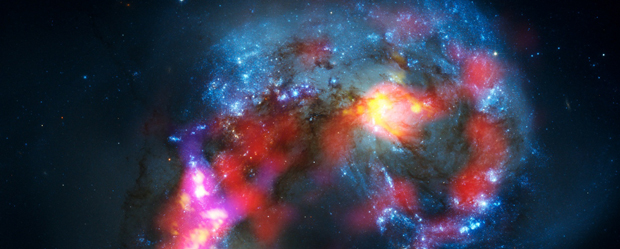Giant telescopes to study deep space matter
The world’s largest and most complex astronomical observatory officially opens for business in Chile. Science Correspondent Tom Clarke is there.
The Atacama Large Millimetre Array (Alma) will, its makers promise, see into the coldest, darkest recesses of the universe – places ordinary optical telescopes cannot reach.
Alma is located in Chile’s Atacama desert. The place looks like the surface of Mars, but that is not why astronomers chose the location. It hardly ever rains here and it is very high up. So with little atmosphere to look through and not a cloud in the sky, it is perfect for studying the stars.
And this latest telescope to be built here exploits those environmental extremes to the full. Alma is 5,000 metres up, where there is only half the air found at sea level. Visiting the telescope requires a compulsory medical and a bottle of oxygen.
This is astronomy on a vast scale. Alma consists of 16 dish-shaped antennae, spread out on the Chanjnantor plateau. Unlike optical telescopes that use lenses and mirrors, Alma “sees” the shortest frequency of radio waves.
We can see clusters of the earliest galaxies being formed. Richard Hills, project scientist
These are given off by the coldest, and therefore invisible, parts of our universe. To allow it to capture such faint signals the telescope needs to be in a place as close to the cold and dry space it studies.
“There’s a lot of stuff in the universe that’s very, very, cold,” says Richard Hills, Alma project scientist.
“We can see clusters of the earliest galaxies being formed and the cosmic microwave background – the light left over from the Big Bang.”
The Alma scientists even think they will be able to see the shadows left by elusive dark matter – the invisible stuff of which 95 per cent of the universe is made up.

By 2013, there will be 66 antennas arranged across the plateau, some as much as 10 miles apart. Using a powerful supercomputer and some clever mathematics, the signals from each dish can be combined to form one image.
The sheer scale of Alma combined with the latest sensors on its dishes give it the fine resolving power that has not been achieved before.
The dishes, mostly made of carbon fibre, can be moved around the plateau on a specially designed transporter – by parking the dishes close together or spreading them apart, astronomers hope to be able to “zoom” in and out on the objects they are studying.
The first image taken by Alma reveals previously unseen clouds of gas in the appropriately named Antennae galaxies. The total amount of gas is billions times the mass of our sun and makes up material for forming future stars. The formation of stars is fundamental to how solar systems like ours came to be and is one of the most intensely studied areas of astronomy.
Not cheap
Alma was built by the European Southern Observatory (ESO), a consortium of 14 European countries as well as Japan and the United States. Engineers and a handful of astronomers at the site carry out studies submitted to them from research teams around the world. In its first few weeks of operation, the telescope is already oversubscribed.
But projects like Alma do not come cheap – its billion euro price tag is difficult to justify in a time of earthly economic woes. ESO sold Alma to governments by guaranteeing construction contracts went only to high tech industries in the partner countries.
The financial outlook is not as clear for ESO’s next big project, the European Extremely Large Telescope – the largest optical telescope in the world with a 39 metre mirror.
“The ELT will get built,” says ESO astronomer Fernando Selman.
“It just might not be next year.”